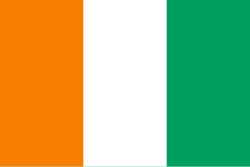

The following outline is provided as an overview of and topical guide to Ivory Coast:
Contents
- General reference
- Geography of Ivory Coast
- Location
- Environment of Ivory Coast
- Regions of Ivory Coast
- Demography of Ivory Coast
- Government and politics of Ivory Coast
- Executive branch of the government of Ivory Coast
- Legislative branch of the government of Ivory Coast
- Judicial branch of the government of Ivory Coast
- Foreign relations of Ivory Coast
- Law and order in Ivory Coast
- Military of Ivory Coast
- History of Ivory Coast
- Period-coverage
- History of Ivory Coast, by subject
- Culture of Ivory Coast
- Art in Ivory Coast
- Sports in Ivory Coast
- Economy and infrastructure of Ivory Coast
- Education in Ivory Coast
- Health in Ivory Coast
- See also
- References
- External links
- Government
- News
- Overviews
- Culture
- Directories
- Tourism
- Other
Ivory Coast – country in West Africa. An 1843–1844 treaty made Ivory Coast a protectorate of France and in 1893, it became a French colony as part of the European scramble for Africa. Ivory Coast became independent on 7 August 1960. Through production of coffee and cocoa, the country was an economic powerhouse during the 1960s and 1970s in West Africa. However, Ivory Coast went through an economic crisis in the 1980s, leading to the country's period of political and social turmoil. The 21st century Ivorian economy is largely market-based and relies heavily on agriculture, with smallholder cash crop production being dominant. The country's official name is the Republic of Côte d'Ivoire.




